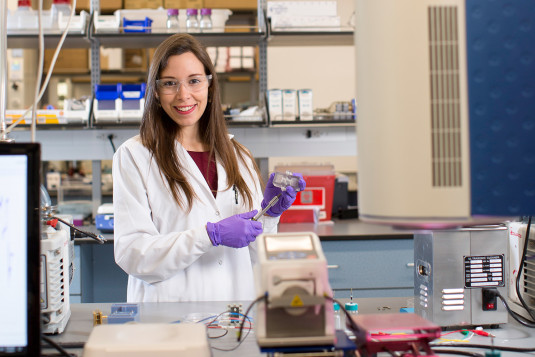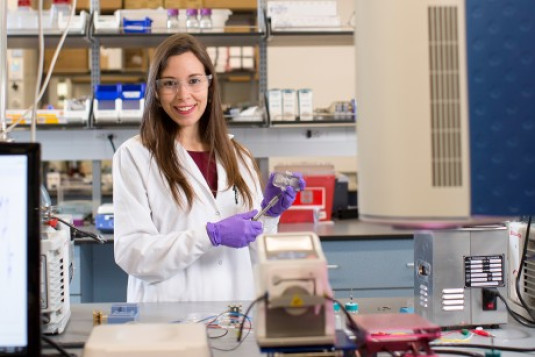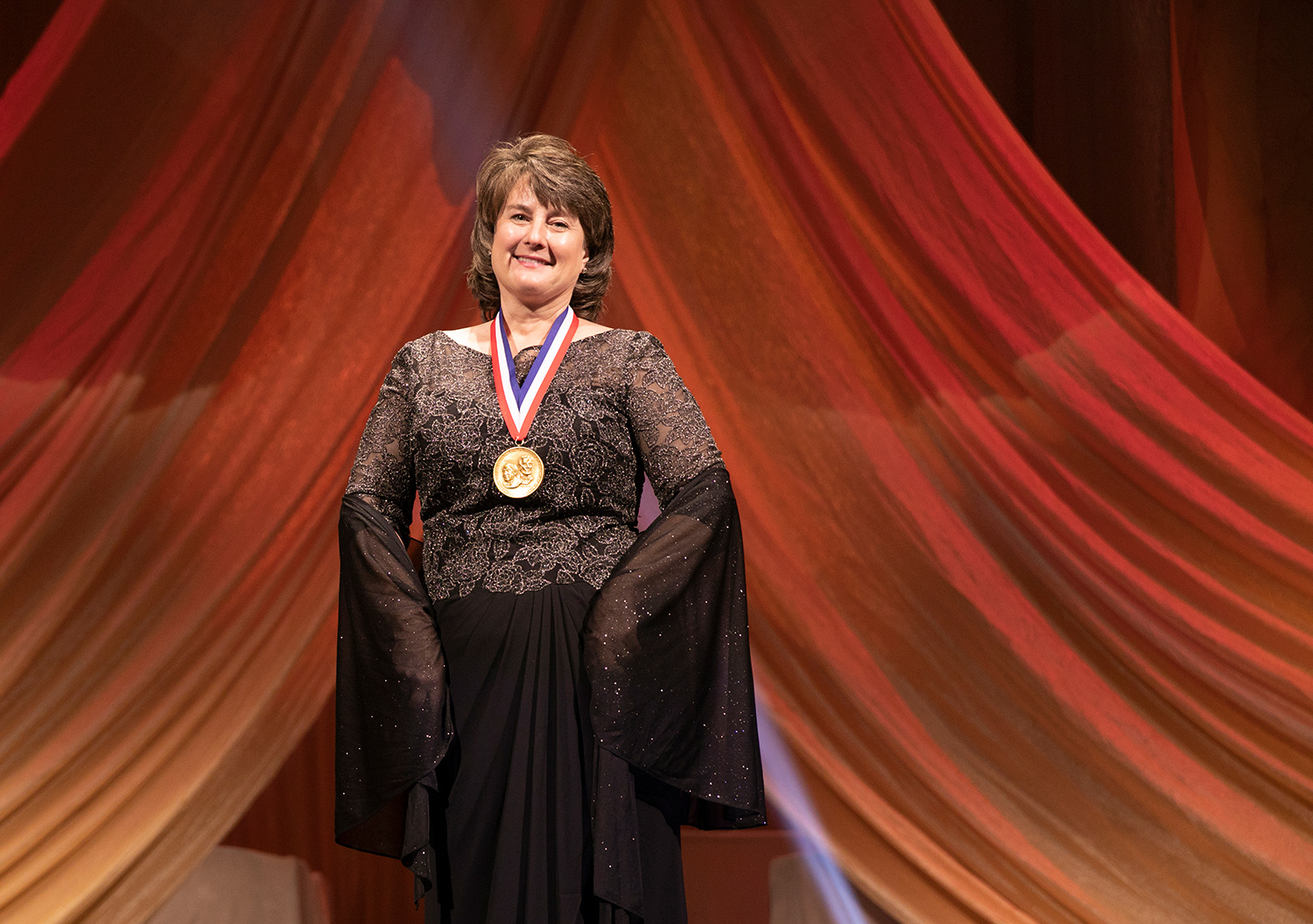
From the ground up
As the child of two science educators, Jackie Quinn developed a love for science at an early age. Now an environmental engineer at NASA, Quinn has combined her innate appreciation of the environment with an innovative spirit to help create an emulsion system that removes contaminants from our groundwater.
17 min read
Each month, our Journeys of Innovation series tells the stories of inventors or entrepreneurs whose groundbreaking innovations have made a positive difference in the world. Hear it in their own words or read the transcript below.
Jackie Quinn: I think that when we start out with asking a question and looking for the answer, it is the diverse ideas on the team that eventually lead us to finding a solution to the question we asked.
Linda Hosler: Teamwork was key for NASA environmental engineer Jackie Quinn as she worked to develop emulsified zero-valent iron. Known as EZVI, this environmental cleanup system was designed to target and remove very concentrated contaminants left in our groundwater from the early days of the space exploration program. Of all the amazing NASA inventions you might be aware of—baby formula, memory foam, and cochlear implants to name just a few—it is actually Quinn’s EZVI invention that is the most licensed NASA technology ever.
I’m Linda Hosler from the United States Patent and Trademark Office. Recently, I spoke to Quinn about the critical need for EZVI and the positive difference her team’s work is having on the environment. Here is a bit of our conversation.
“[I]nnovation takes a lot of forward steps and then probably even more backward steps, and then you finally get there.”
Linda Hosler: Tell me a little bit about your inventions, particularly of course, emulsified zero-valent iron, EZVI, but also your other inventions and their impact.
Jackie Quinn: So I’ve had the opportunity to work on several environmental cleanup technologies over the years. And one of the most heavily used and most known is a technology called emulsified zero-valent iron. It’s actually a collaborative effort with University of Central Florida and NASA in the development of it. And I have several co-inventors that participated on the team with me. Often people call me as the NASA person, but I just want to make sure that I, I point out that it’s such a collaborative effort and a great teamwork that we had in developing EZVI, as it’s more commonly known. The emulsified zero-valent iron is an emulsion system that is used in the subsurface in the groundwater to clean up contaminants that may be decades of years old, and has been contaminating groundwater systems across the globe.
Linda Hosler: Talking about EZVI, could you talk a little bit about how you approached the problem you wanted to solve?
Jackie Quinn: EZVI was specifically designed to target some of the, what we call chlorinated aliphatics, or the more common products that we know of them as like dry cleaner fluids. In NASA’s case, we used it for cleaning rocket engine parts. We had to make sure all of the parts are very, very clean, so we didn’t have an unintended deflagration or burning or creating an unintended explosion. And so all of the rocket engine parts had to be very, very clean before we would actually put them into use using our fuels for propulsion to space. And the way we did that in the, you know, from the 1960s—1950s when we first started the Mercury, Gemini programs, Apollo programs—is we use chlorinated solvents as our cleaning fluid. And then that chlorinated solvent that we would do that cleaning with was disposed of.
And back in the 1950s and ’60s, that disposal mechanism was very different. We were unaware during that time that there was a human health issue associated with it. So all of the manufacturer’s guidance for disposal was that it was okay to just dispose of to ground and flush. So we do have some large contamination areas across almost all of the NASA centers because we were existing and working in those environments in the 1960s. So, just the technology was way ahead for the space agency, but the guidance and the understanding of the disposal practices were very far behind with that agency being so much younger than the space agency.
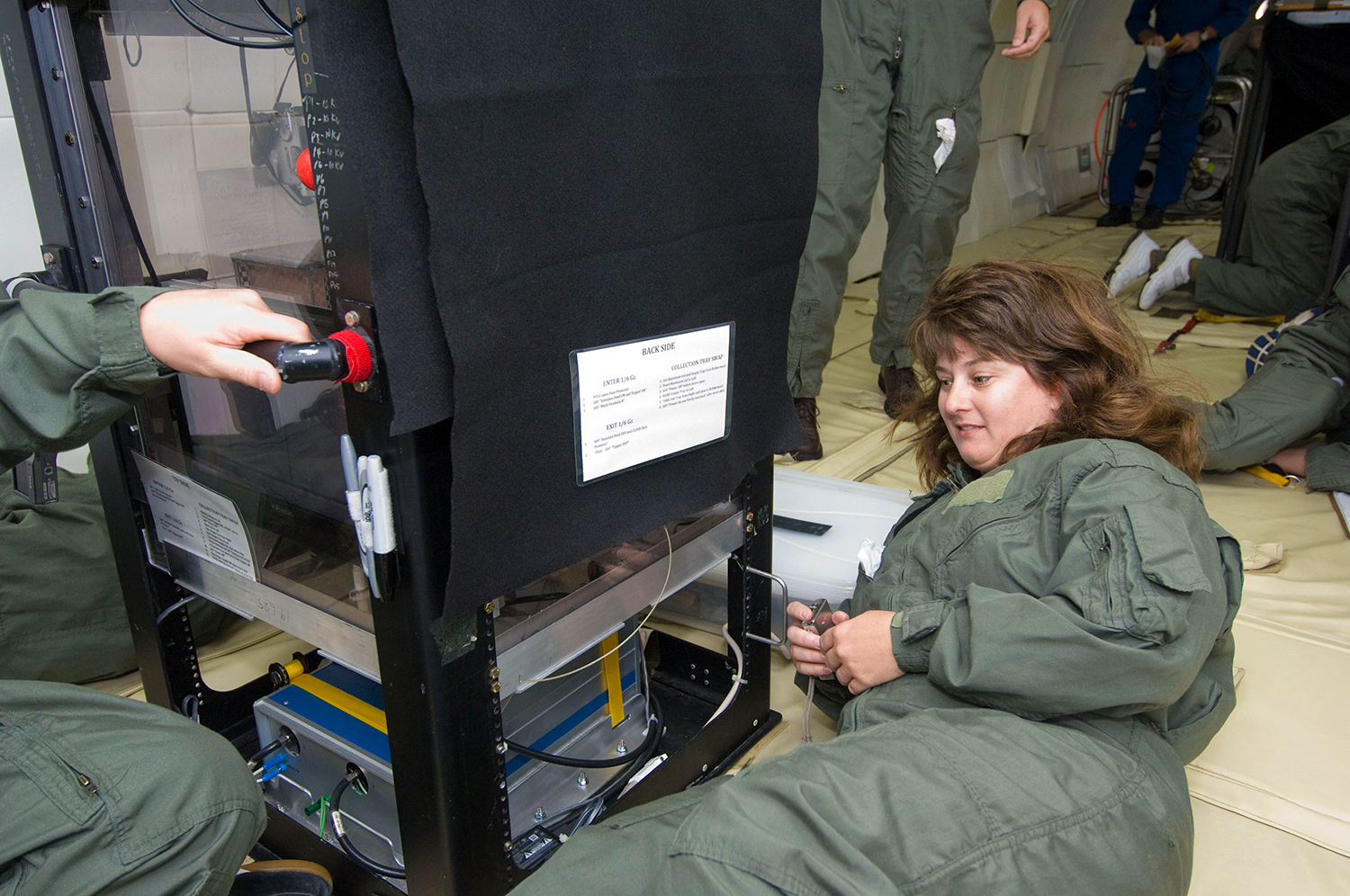
Jackie Quinn and her team received U.S. patent no. 6,664,298 for zero-valent metal emulsion for reductive dehalogenation of DNAPLs (EZVI) on December 16, 2003. Photo courtesy of Jackie Quinn/NASA.
Jackie Quinn: So, we put a team of a very disparate group of individuals together, with different skill sets, to work on EZVI to clean up these very high concentration contaminants. And together, we worked out the chemistry necessary to create this emulsion system. And then together we worked on how do we put it into the ground, and how do we manufacture it, because that was a big thing. I think a lot of times when you come up with a concept idea, you can make it work in the lab on a very, very small scale, but to be able to make it on a large scale and make it something that you can actually deploy, you know, in order to meet the commercial needs or the site, the government needs—the site needs—you need to be able to make it on a large scale.
Salad dressings are a really good example of an emulsion system. So you know, a salad dressing, if you put oil and vinegar together or oil and water, you’re not going to mix them, right? They’re not going to talk to one another. They just stay in two phases. You can shake them as long as you can shake them, but they’re not going to go into a single phase. But if you put a surfactant in there, a surfactant having—it’s a long molecule, and on one end it’s polar and the other it’s nonpolar. It’s, on one side it talks to a hydrophobic substance, and on the other end of the molecule it talks to a hydrophilic substance. If you add in a surfactant, then you can mix that and make an emulsion system much like your salad dressings or your mayonnaise.
Linda Hosler: I understand that you, when you first started working at NASA, you started working on, you were working on the shuttle program, but then you switched to the environmental side. Could you talk a little bit about what prompted that switch?
Jackie Quinn: Well, I worked almost two years on shuttle. I worked in the Environmental Control and Life Support System, but I had gone back to work—start work—on my master's part-time, and I really wanted to get into more of the environmental side, and so one of the great things about working for NASA, the agency, is that they recognize that people have skills that are beyond necessarily where you start. And they have ability to apply those skills in different areas within the agency. And so I applied to move to work in an area where I would do more environmental cleanup, and that was really prompted by a lot of the work that I was doing to get my master's ’cause I had gone back part-time to get my master's in environmental engineering.
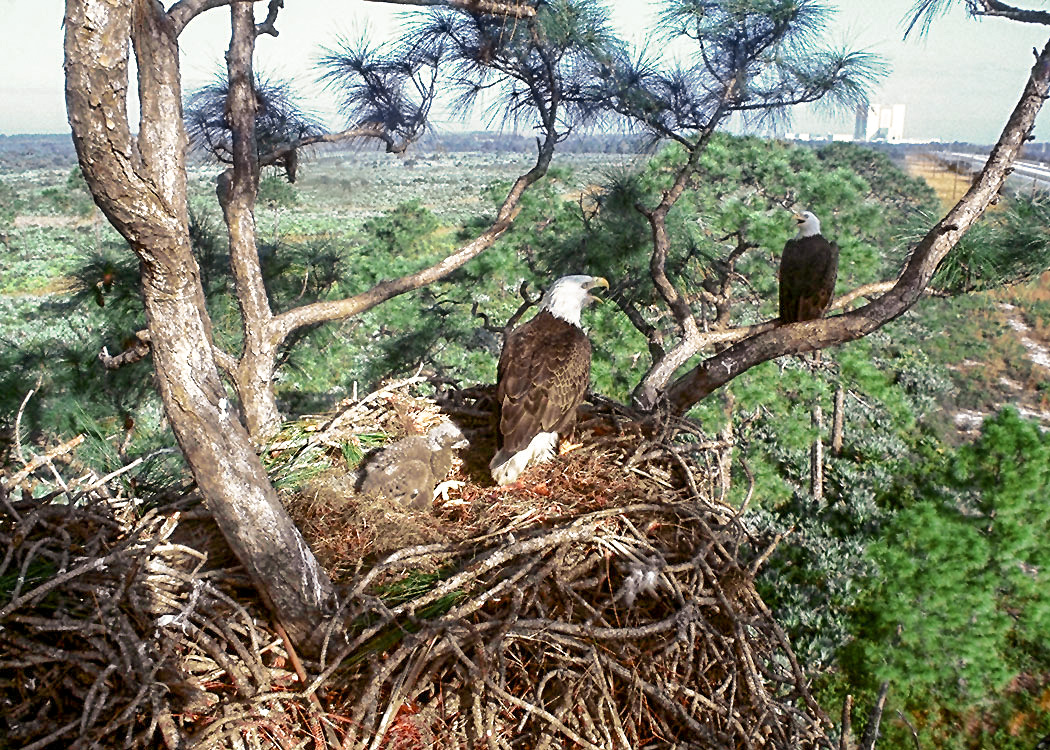
EZVI works to protect animals and wildlife habitats by removing strong contaminants from polluted water. Above, bald eagles reside in the Merritt Island National Wildlife Refuge, which is close to the Kennedy Space Center in Florida. Photo courtesy of NASA.
Linda Hosler: A lot of people might be surprised that NASA even has an environmental side.
Jackie Quinn: NASA landed a man on the moon July 20, 1969, and the United States did not establish the USEPA [U.S. Environmental Protection Agency] until December of 1970. So almost a year—a little over a year—later, we were having the ability to understand the implications of some of the disposal practices that were utilized globally and legally. It wasn’t as if anybody was doing anything against the law, it’s just that all, all industry, whether it was government or private, did not have a full understanding of the impact of their disposal practices in the 1960s. And NASA was no different. So we have 11 centers across the United States, and each of them, minus NASA headquarters in Washington, each of them has a form of contamination in their environment—whether it be water, soil, groundwater—that they’re attempting to clean up.
It’s kind of interesting that EZVI, which I spoke of earlier, to date, that is the most licensed technology for NASA, of all of the really amazing, cool stuff that NASA has developed over the years. It’s, you know, ranges from, from environmental to aerospace applications to space applications to satellites. You know, we have a broad patent licensing field that we deploy within. You know, our technologies kind of fit a large range, but the most licensed to date is EZVI, which is an environmental cleanup technology.
“And that, that ‘I wonder’ statement ... makes you kind of pause and say, ‘You know, is there something in here that I should go investigate further?’ when you’re trying to find the solution.”
Linda Hosler: Can you tell me a little bit about what you’re working on now?
Jackie Quinn: Right now, I’m not doing anything with environmental work. It’s kind of funny. So the agency’s very interested in going back to the lunar surface. And so I’ve been working with another great team of engineers and scientists on taking a commercial mass spectrometer and converting it to be space-flight worthy, and getting it ready to fly to the moon in 2021. So we’re very excited to have our first modified, commercial, off-the-shelf unit ready to go to the lunar surfaces to look for molecules that are, that we know now are on the surface of the moon.
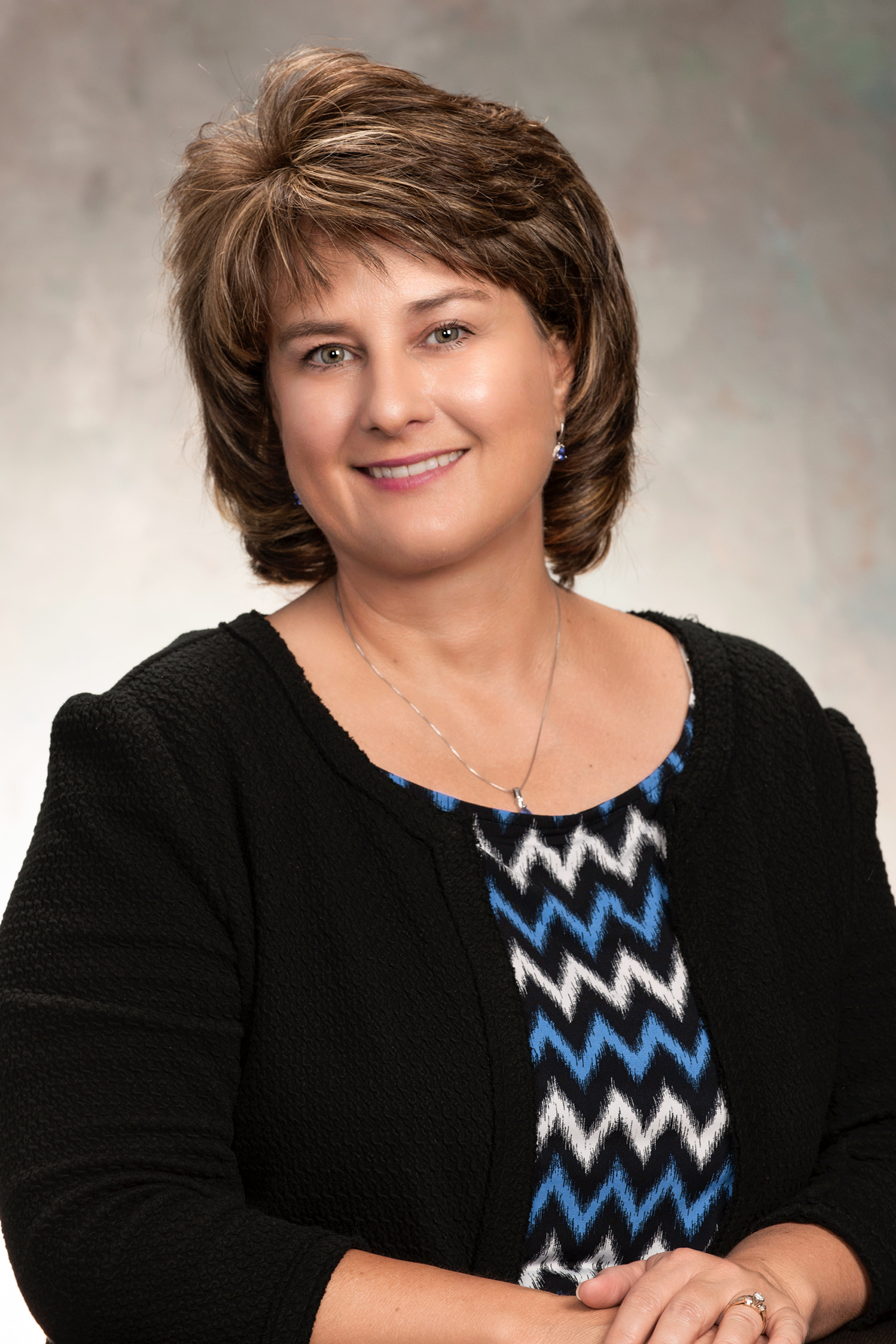
Jackie Quinn. Photo courtesy of the National Inventors Hall of Fame.
Linda Hosler: Was there a specific moment where you felt like, “I am an inventor” or “I want to become an inventor?” Or was that not really the way you were thinking about it?
Jackie Quinn: I don’t know that people come in and think, “I’m going to be an inventor.” Humorously, my, my kids have asked me something very similar. I have two daughters, and they both are in the science and engineering fields. They have asked me, you know, “Mom, how, how did you start thinking that you want to do this?” And I, you know, I tell them, I said, well, I, I really just kind of am always curious, and I think if you asked enough questions, I have, you know, “I wonder if this would happen.” And that, that “I wonder” statement is really, makes you kind of pause and say, “You know, is there something in here that I should go investigate further?” when you’re trying to find the solution.
And I think that inquisitive side is what makes an inventor. If I had to pick one characteristic of somebody, it’s the inquisitive side. And I think one thing that’s made me successful as an inventor is it, you know, I’ll work with a great group of, of team members that add significant value in the development process. So, you know, I don’t have every single idea come out of my head for the entire beginning-to-end development cycle. It’s definitely a team effort. I can’t see ever having done anything without having had that think tank that’s made up of people with very different ways of looking at a solution and a problem—a problem in developing a solution. And so I, I think that that really makes it possible—is having curiosity and then having the open-mindedness to see what other people think about it. And then working together to try to try the different aspects of, you know, try this, try that, do this, do that, and see if it gets you any closer to where you want to be.
Linda Hosler: Is there a specific person or experience that first piqued your interest in science, technology—a teacher, your parents, back in your childhood, perhaps?
Jackie Quinn: Well I’ve had a ... very fortunate in that both my parents are scientists, and they’re actually scientists in the education field, which kind of didn’t give me an option but to love science. Like, you know, it’s interesting to think about how you’re exposed to stuff. My, my mom is—was, was, she’s retired now—but a high school teacher, and she taught science. She taught biology, human anatomy, chemistry. And then my father taught science education for childhood, to try to entice teachers to increase their science exposure at a very young age. So he taught—early childhood science education was his specialty at the university level. So I used to go to my dad’s lab at the university when I was young and, you know, just have fun running around being a kid in a science lab at a very young age. And of course my mom taught science at the high school level, so I don’t know that I really had any options but to be pretty heavily involved in science just because it was so natural in my upbringing.
Linda Hosler: So you talked about your parents being science educators, and you’ve always been interested in science, but I never really got the connection how you became really interested in environmental impacts.
Jackie Quinn: So I went to Georgia Tech and got my undergraduate in civil engineering, and they didn’t have a program in undergraduate environmental engineering. It was civil, which had a small section and then that was part of environmental. So when you got an undergrad or civil degree, you took classes that did include environmental, you took classes that include structural, you took classes in highway design. And so I was going to get my master’s in environmental engineering because I was originally more interested in that sector of civil engineering.
”Learning ’no’ and learning something doesn’t work is key. It’s learning. It’s not ... the same sort of negative. It can be frustrating, but it never keeps you from pushing forward to what is ... the right answer to the ‘I wonder’ statement.”
Linda Hosler: Was it anything in particular about the environment or nature that was particularly inspiring?
Jackie Quinn: You know, I, I think that you have to look back at my childhood, which was spent a lot outside. You know, I, I don’t—didn’t—we didn’t have computers when I grew up, right? That wasn’t a thing we did. I didn’t get my computer until I started working at NASA. I mean, you know, I had to use the ones at the college when I was there in the ’80s. So, you know, you did a lot more outdoor activities as a kid where I grew up, especially, you know, with my parents. I mean, we, we would go on nature hikes. We would go camping. We would, you know, we would be outside, we’d be looking for mushrooms, you know, we would do walks on the nature trail at the college with my father.
I, you know, I just, I was always outside, and so it is a love of, of that outside adventure that I enjoyed. And when I was in coursework, that allowed me to work on technologies and science and math that would enable that environment to sustain itself. That was very intriguing to me. That’s what I wanted to do. It gave me an opportunity to use my skills in math and science and use them for something that I treasured, which was being able to go out into the wildlife refuge, being able to go camping and hiking and ski, water skiing and snow, snow skiing, and you know, all those outdoor activities. And I enjoyed having an opportunity to learn something that I knew could help sustain that.
Linda Hosler: As you know, innovation is not easy and comes with highs and lows. Was there a specific time over the course of your career that you felt that you failed or that you wanted to quit?
Jackie Quinn: No. No, I don’t, I don’t think so. I, you know, I think that failure is, is not a nasty term. I mean, it’s just so normal for me. I mean, you try things, and they don’t work, and you just say, okay, knocked that off my list. Try again. Don’t give up. Learning “no“ and learning something doesn’t work is key. It’s learning. It’s not, it’s not the same sort of negative. It can be frustrating, but it never keeps you from pushing forward to what is the, the right answer to the “I wonder” statement.
Linda Hosler: Invention comes easily to some, and it can very challenging for others. What do you think it takes to be a successful inventor?
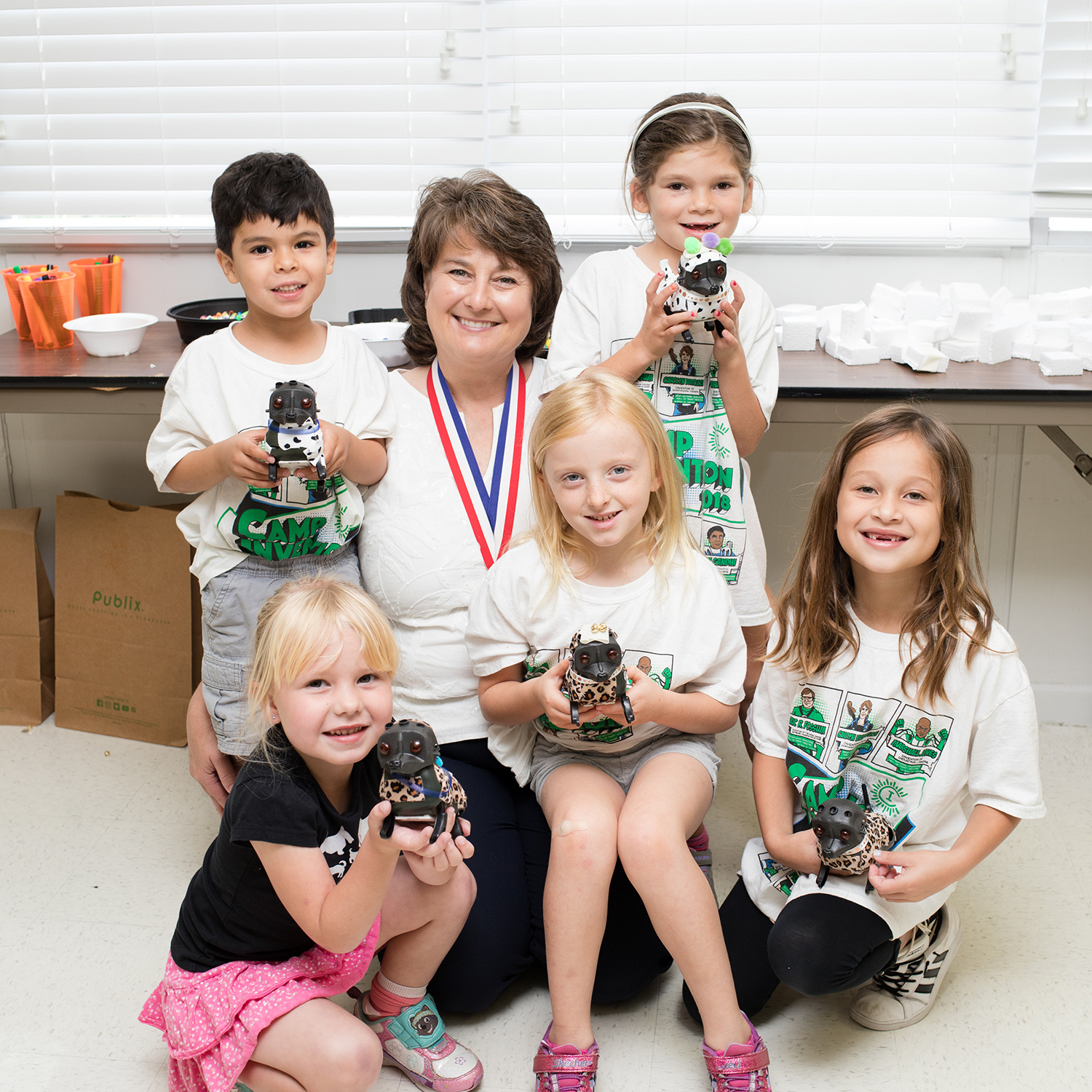
Jackie Quinn visits young participants of Camp Invention in June 2018. Camp Invention is a STEM summer program led by the National Inventors Hall of Fame. Photo courtesy of the National Inventors Hall of Fame.
Jackie Quinn: To be a successful inventor, I think it, it takes one who’s not afraid to, to ask the question and not, not afraid to, to try to find solutions and know that they’re not going to get it right every single time. You have to be accepting and understand that innovation takes a lot of forward steps and then probably even more backward steps, and then you finally get there.
Linda Hosler: Given your own experiences and speaking to a wide audience, what advice would you give to other innovators?
Jackie Quinn: Don’t give up. Remember that the answers are there, and it’s okay to get this didn’t work. And, and keep trying because this didn’t work is just as important as what would—did—work. And I would say just always go in with an open mind, and surround yourself with people that think differently than yourself and that you’re not seeing the forest for the trees.
Linda Hosler: You’ve talked a lot about appreciating teamwork and, and as a big part of your, big part of invention. Could you talk about why teamwork is so important?
Jackie Quinn: Well, teams are, teams are what make the invention possible in my opinion. I think that when we start out with asking a question and looking for the answer, it is the diverse ideas on the team that eventually lead us to finding a solution to the question we asked. I don’t know that any of my work would’ve have come to as positive of an outlook and a—had as large of an influence on, you know, or had as large of a global impact for example, as EZVI has had it not been done and executed in a team setting. And I personally am forever enriched by having worked alongside these other scientists and engineers because they make me better.
Linda Hosler: Could you talk about why it was so important to receive a patent for your invention?
Jackie Quinn: We use the patenting process to capture the intellectual property and then to be able to share it with the commercial sector in hopes of having it favorably impact other sectors across the U.S. or the globe, depending on if it’s a U.S. patent or it holds, you know, or if there’s foreign patent production as well.
But unless we license it, we don’t have that tool made available to influence and help the global effort for groundwater cleanup. So in that respect, getting the patent for EZVI and then licensing it to multiple end users, we actually did have a very favorable environmental footprint left behind because we went through the patent—patenting and licensing process.
”[W]hat I’m most proud of is that I can say that, you know, in my years here on this planet, I did something protective of the environment. And I can also say that I’ve done something proactively to advance science space exploration, which I think is kind of cool, too.”
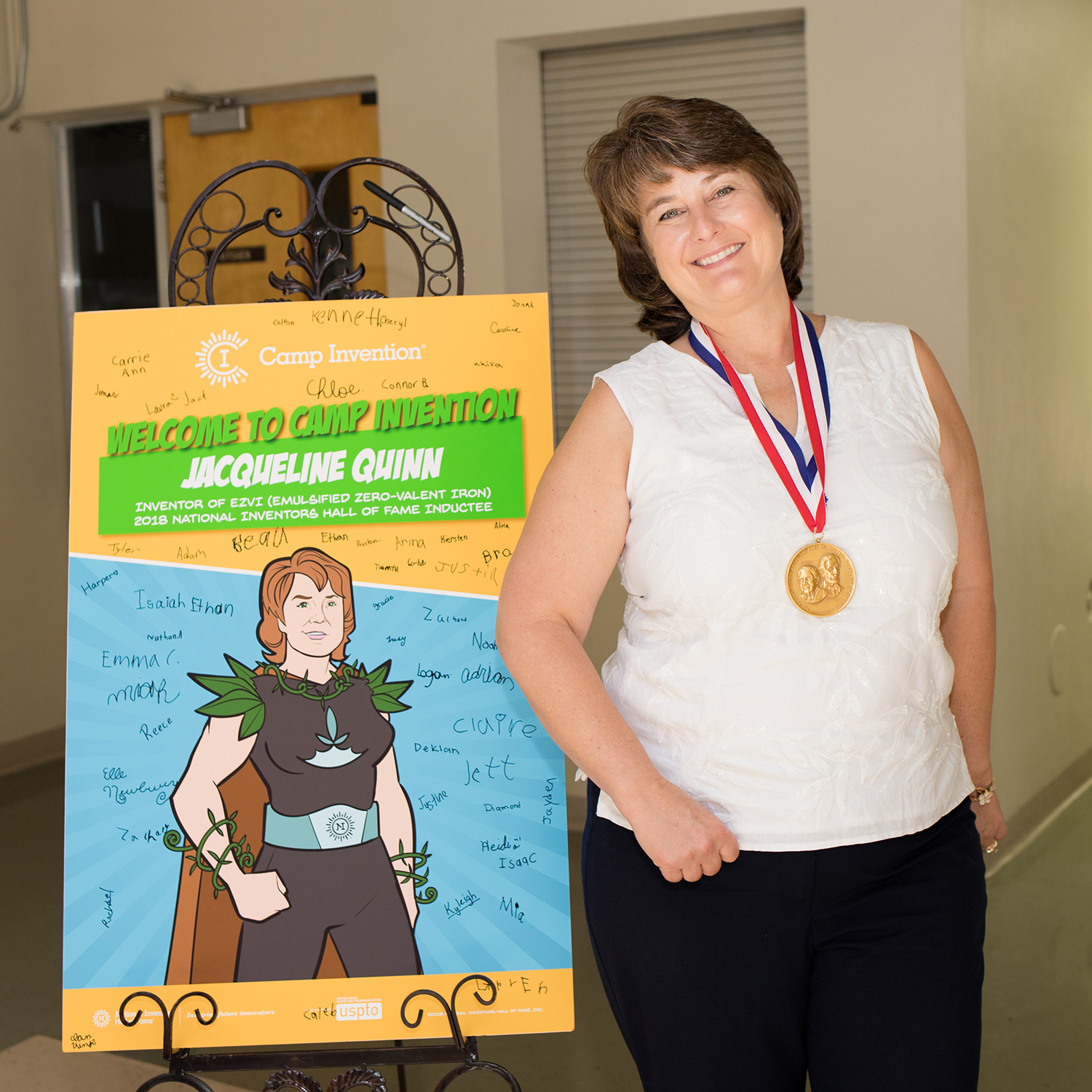
Jackie Quinn poses near a rendering of herself as a superhero for Camp Invention in June 2018. Photo courtesy of the National Inventors Hall of Fame.
Jackie Quinn: So, so our efforts at patenting our technology and then actually going out and looking to get licensees on it and teaching them either how to manufacture it in the case of EZVI or how, how it, you know, technically operates and working with them to get it commercially available is a metric for us because we do want to make sure that the technology we get is available and is making a larger impact.
Linda Hosler: The last question I have for you is looking back at the impact of your inventions over the course of your career, what are you most proud of?
Jackie Quinn: I like, well obviously, I like to look back and say I made a difference to the environment, and I think it’s really cool that I made a difference in my, basically my own backyard because the technology was actually used in my county outside of NASA to create clean groundwater for, you know, people that I live and work with and, you know, go to school with and that kind of thing. I think, you know, if I look back and, and I see an impact, a favorable impact, I see that that is probably what I’m most proud of is that I can say that, you know, in my years here on this planet, I did something protective of the environment. And I can also say that I’ve done something proactively to advance science space exploration, which I think is kind of cool, too. So I don’t, I don’t have any real negative impact. I mean, nothing I look back on and say I’m not happy with, so I’m pleased that I’m, I’m able to say that I made an environmental impact and that I am participating in supporting our space exploration.
Linda Hosler: Many thanks to Jackie Quinn for taking the time to discuss her impactful work on the environment and the importance of teamwork and curiosity. By asking the “I wonder” question, she continues to turn imagination into reality. From the USPTO, thanks for listening.
Credits
Produced by the USPTO Office of the Chief Communications Officer. For feedback or questions, please contact inventorstories@uspto.gov.
Interview by Linda Hosler. Audio editing by Jay Premack. Story production by Lauren Emanuel. Additional contributions from Marie Ladino. Photo at top of page of Jackie Quinn at the 2018 National Inventors Hall of Fame Induction Ceremony by Jason Dixson Photography. All other photos credited in captions.
References
“Jacqueline Quinn.” National Inventors Hall of Fame, 2018. https://www.invent.org/inductees/jacqueline-quinn.
“Cleaning Contaminated Groundwater Is EZ(VI).” NASA, 2012. https://www.nasa.gov/offices/oct/home/tech_life_ezvi.html.


